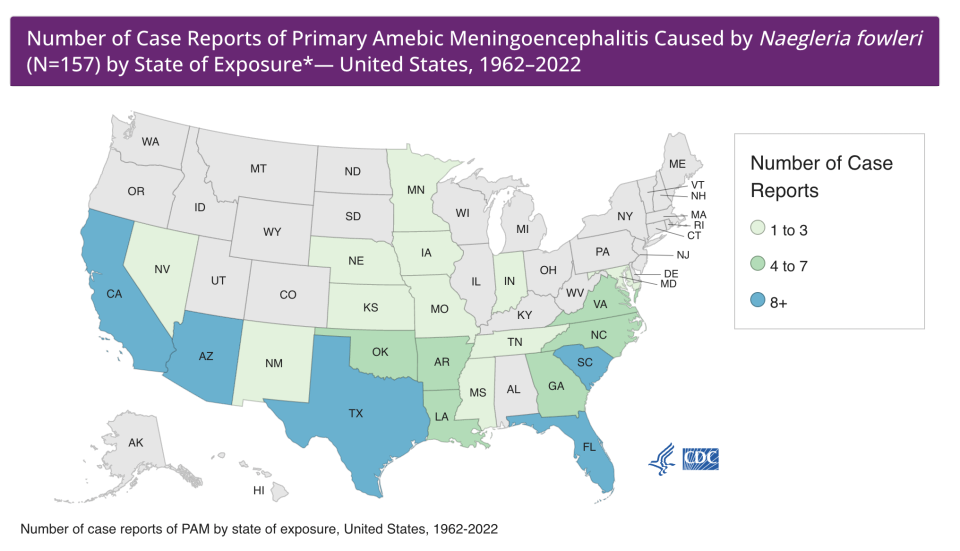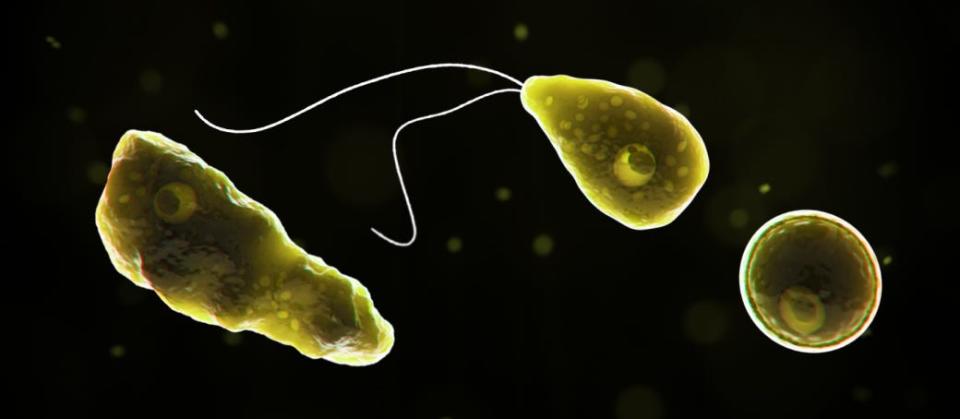As water temperatures climb, do you know how to lower your risk for 'brain-eating' amoeba?
You may not have heard of Naegleria fowleri by its scientific name, but chances are you may have heard about a brain-eating amoeba.
And as water temperatures continue to climb in Florida and across the U.S., it pays to be cautious when it comes to the deadly amoeba that love warm fresh water.
Here's what you should know about the amoeba, where it can be found, symptoms to watch for and how you can protect yourself and your family.
What is Naegleria fowleri?

Naegleria fowleri, commonly called the "brain-eating amoeba," is an amoeba that occurs naturally around the world, often in warm or hot freshwater — such as lakes, rivers and hot springs — and soil, according to the Centers for Disease Control.
In very rare instances, people have been infected by recreational water that didn’t have enough chlorine in it, such as pools, splash pads, or surf and water parks.
Where can the brain-eating amoeba be found?
According to the CDC and WebMD, The amoeba can be found in:
Warm fresh water, such as lakes, rivers, ponds and rock pits.
Mud puddles.
Geothermal (naturally hot) water, such as hot springs.
Warm water discharge from industrial or power plants.
Untreated geothermal (naturally hot) drinking water sources.
Swimming pools, splash pads, surf, and water parks, or other recreational venues that are poorly maintained or don’t have enough chlorine in them.
Tap water.
Untreated well water or untreated municipal water.
Water heaters.
Soil, including sediment at the bottom of lakes, ponds, and rivers.
Aquariums
Naegleria fowleri does not survive in salt water.
How are people infected by the brain-eating amoeba?
Naegleria fowleri amoebae travel up the nose and into the brain. This causes an infection called primary amebicmeningoencephalitis or PAM, which destroys brain tissue and causes brain swelling and death.
People are infected when water containing the amoeba enters the body through the nose. Infections are most oftenassociated with swimming or diving during the summer in warm freshwater, such as lakes and rivers.
Sometimes infections occur after people put their head underwater in hot springs.
Infections have also happened when people use contaminated drinking water to cleanse their nasal passages or get the contaminated water up their nose during recreational play.
Can you get the brain-eating amoeba by contact with an infected person or drinking contaminated water?
No. You cannot be infected with Naegleria fowleri by drinking contaminated water.
There is no evidence Naegleria fowleri can spread through water vapor or aerosol droplets (such as shower mist or vapor from a humidifier), so the infection cannot spread from one person to another, the CDC said.
How deadly is a Naegleria fowleri infection?

Naegleria fowleri infections are rare, but the death rate is over 97 percent.
In the United States, between zero and five cases were diagnosed annually from 2013 to 2022, according to the CDC. During this period, a total of 29 infections were reported in the United States.
Texas leads the country with 39 cases from 1962 through 2022. Florida came a close second, with 37 cases reported.California was the only other state to hit double digits, coming in third with 10 cases.
Of 157 people known to be infected in the U.S. from 1962 to 2021, only four people survived.
How many infections have happened in Florida?

Prior to 2008, primary amebic meningoencephalitis was not a reportable disease in Florida, according to the Florida Department of Health.
Thirty-eight cases have been documented with Florida exposures from 1962 through 2020, according to the Florida Department of Health. The number differs by one case from figures released by the CDC.
Reported cases described exposures in 19 of Florida's 67 counties: Baker, Brevard, Broward, Citrus, Hendry, Hillsborough, Lee, Madison, Orange, Pasco, Pinellas, Polk, Putnam, Palm Beach, Seminole, Volusia and three unknown counties.
One additional case was a Florida resident who acquired the disease at a natural hot springs recreational water venue in a Central American country.
All Florida cases died from the disease with the exception of a 2016 case. All but three cases were residents of Florida.
A Charlotte County man died earlier this year. The case was thought to be caused by rinsing his sinuses with tap water, said Jae Williams, press secretary with the Florida Department of Health.
Florida death: Florida resident dies after contracting brain-eating amoeba from tap water
When was the last case of brain-eating amoeba reported in Florida?
The Florida Department of Health in Charlotte County confirmed a case in February. The person may have been infected by rinsing sinuses with tap water.
How can you protect yourself from brain-eating amoebae?
Assume that there is always a low level of risk of Naegleria fowleri infection in warm freshwater lakes, rivers, and hotsprings, especially in southern states.
The only certain way to prevent an infection is to avoid water-related activities in warm freshwater.
If you do decide to swim, reduce the risk of infection by:
Holding your nose shut, using nose clips, or keeping your head above water.
Avoiding putting your head underwater in hot springs and other untreated geothermal waters.
Avoiding water-related activities in warm freshwater during periods of high water temperatures.
Avoid digging in or stirring up the sediment in shallow, warm freshwater areas.
If you're rinsing your sinuses, lower your risk of infection by:
Use water that has been previously boiled for 1 minute and left to cool. At elevations above 6,500 feet, boil for 3 minutes.
Use a filter designed to remove some water-loving germs.
The filter label may read NSF 53 or NSF 58.
Filters that read “absolute pore size of 1 micron or smaller” are also effective.
Use water with a label specifying that it contains distilled or sterile water.
Learn how to disinfect your water to ensure it is safe from Naegleria fowleri.
Chlorine bleach used at the right level and time will work as a disinfectant against the amoeba.
Rinse your nasal irrigation device after each use with safe water, and leave the device open to air dry completely.
What water temperatures do the amoebae thrive in?
The amoebae thrive in heat and like warm water. They grow best at high temperatures up to 115 degrees and can survive for short periods at even higher temperatures.
Scientists have tested water temperatures from lakes and rivers linked to some primary amebicmeningoencephalitis cases, and the temperatures have typically been higher than 80 degrees. However, it is possible the amebae may live in water with a temperature below 80 degrees, the CDC reported.
Can you be infected by Naegleria fowleri in a swimming pool?
You cannot get a Naegleria fowleri infection from a properly cleaned, maintained, and disinfected swimming pool.
In very rare instances, the amoeba has been found in swimming pools, splash pads, surf parks, or other recreational venues that are poorly maintained or don’t have enough chlorine in them.
When do most infections happen?
Infections usually happen when temperatures are hot, which results in higher water temperatures and lower water levels.
While infections with Naegleria fowleri are rare, they happen mainly during the summer months of July, August and September.
Can PAM be cured?
Because PAM is so rare, and because the infection progresses so quickly, effective treatments have been challenging, the CDC said.
There is some evidence certain drugs may be effective, but researchers are still learning about the best drugs to treat the infections.
Currently, PAM is treated with a combination of drugs, often including amphotericin B, azithromycin, fluconazole, rifampin, miltefosine, and dexamethasone. These drugs are used because they are thought to be effective against Naegleria fowleri and have been used to treat patients who survived.
Miltefosine is the newest of these drugs. It has been shown to kill Naegleria fowleri in the laboratory and has been used to treat three survivors.
What are the symptoms of Naegleria fowleri and when do they occur?
Symptoms can be mild at first, but they worsen quickly, according to the Centers for Disease Control.
Symptoms usually start about five days after infection but can range from one to 12 days.
Headache
Fever
Nausea
Vomiting
Later symptoms can include:
Stiff neck
Confusion
Lack of attention to people and surroundings
Loss of balance
Seizures
Hallucinations
After symptoms start, the disease causes death within about five days but can range from one to 18 days.
If you experience any of these symptoms after swimming in warm lakes or rivers, or after a nasal water exposure such as a sinus rinse, seek medical assistance immediately, said the Florida Department of Health.
Can we expect more cases of Naegleria fowleri because of climate change?
It is possible Naegleria fowleri infections will become more common because of climate change, the CDC said.
While most U.S. infections have been reported in the South, cases have been reported in more northern states in recent years.
As air temperatures rise, water temperatures in lakes and ponds also rise and water levels may be lower. These conditions provide a more favorable environment for the amoeba to grow. Heat waves, when air and water temperatures may be higher than usual, may also allow the amoeba to thrive.
Since 2010, cases have been confirmed in more northern states such as Nebraska, Iowa, Minnesota, Indiana, Maryland, and northern California, which suggests a northward expansion of cases.
This article originally appeared on Treasure Coast Newspapers: Brain-eating amoeba: Where Naegleria fowleri is, how infected, symptoms

